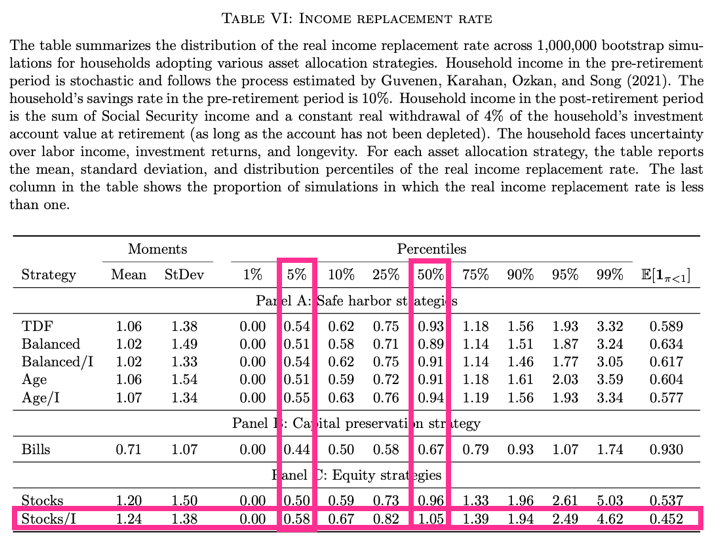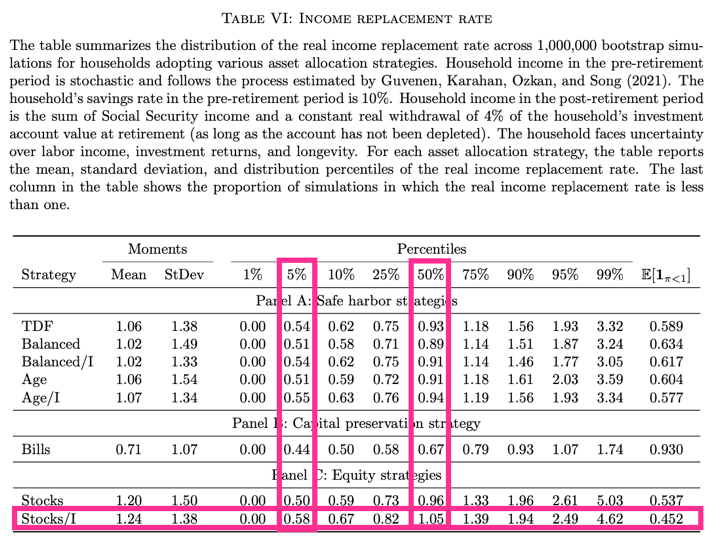The academic paper Beyond the Status Quo: A Critical Assessment of Lifecycle Investment Advice by Anarkulova, Cederburg and O’Doherty had a conclusion that caught my eye. From the abstract:
We challenge two central tenets of lifecycle investing: (i) investors should diversify across stocks and bonds and (ii) the young should hold more stocks than the old. An even mix of 50% domestic stocks and 50% international stocks held throughout one’s lifetime vastly outperforms age-based, stock-bond strategies in building wealth, supporting retirement consumption, preserving capital, and generating bequests.
Now, the actual paper was not written for non-academics and there was very slim pickins’ in the “easy-to-understand graphic that summarizes our results” department, but I’ll try my best. They studied 8 different portfolios, summarized below. (They also picked the names.)
- TDF. Follows the asset allocation of the most popular target-date funds, which use a glide path that starts at 90% equities but reduces equity percentage over time.
- Balanced. 60% US stocks, 40% bonds.
- Balanced/I. 30% US stocks, 30% International stocks, 40% bonds.
- Age. (120-Age)% US stocks, (Age-20)% bonds.
- Age/I. (60-Age/2)% US stocks, (60-Age/2)% International stocks, (Age-20)% bonds.
- Bills. Invests only in Treasury bills.
- Stocks. 100% US stocks.
- Stocks/I. 50% US stocks, 50% International stocks.
In the chart below, the authors show the equivalent savings rate that would have been required to reach the same level of “expected utility of retirement consumption” (retirement income provided + leftover money at death) throughout the entire lifecycle of a 10% savings rate during the working years and then spending it down at a 4% withdrawal rate in retirement.
Let’s look at the highlighted pink box. This is the line for the best performing portfolio of 50% US stocks, 50% International stocks (“Stocks/I”). In order to have gotten the same amount of retirement income + bequest as a 10% savings rate with Stocks/I, you would have had to save 14.1% with a TDF, 16.9% with the Balanced portfolio, and so on. Note that staying in cash “bills”, you would need to ratchet up to 47% savings rate!
In another chart, we see that 50% US stocks, 50% International stocks (“Stocks/I”) also creates the highest income replacement rate in retirement, based on a 10% savings rate. This is true on average (50% percentile) and even in the worst-case scenarios (5th percentile), as long as you stayed with the plan. The drawdowns would have been temporarily more severe over certain periods of time, however.

My takeaways are:
- You might consider a 100% stock portfolio with international exposure, if you really have the stomach for it. I’d probably recommend waiting until after you have survived a 50% crash first. Optimally, your portfolio would grow so much that by retirement, you may not even need a 4% withdrawal rate.
- All of the other portfolios that contains some bonds (TDF, Balanced, Balanced/I, Age, Age/I) had very similar results over the entire lifecycle of accumulation and spending down. They still did pretty well.
- Everyone should definitely own a good chunk of stocks, as trying to accumulate enough money with just safe “cash” in the form of Treasury bills or bank accounts is going to require in the neighborhood of five times the savings rate.




